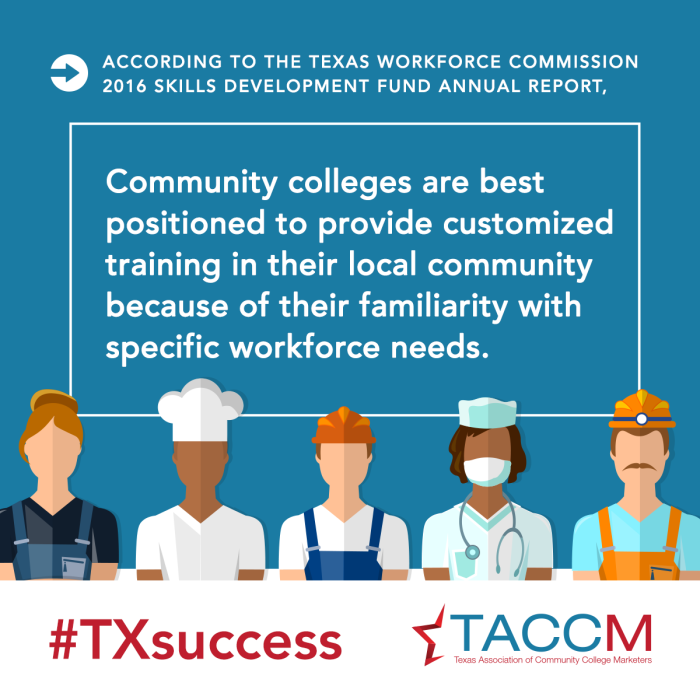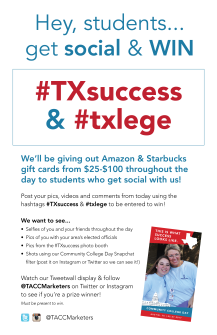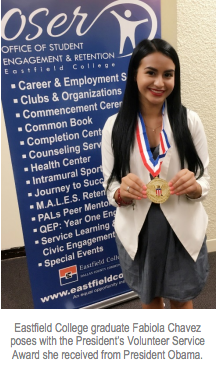(Austin, TX) The Texas Success Center (TSC), a division of the Texas Association of Community Colleges (TACC), is pleased to announce the partnership with the Bill & Melinda Gates Foundation, the Greater Texas Foundation, T.L.L. Temple Foundation, and the Teagle Foundation to launch an ambitious five-year effort to implement Texas Pathways reform across all 50 community college districts in the state.
Texas Pathways is an integrated, system-wide approach to student success based on intentionally designed, clear, coherent and structured educational experiences that guides each student effectively and efficiently from the selection of their high school degree program, to entry into higher education, to attainment of high-quality credentials and careers.
Texas Pathways is patterned after the American Association of Community College (AACC) Pathways Model launched nationally in 2015. Texas Pathways is built upon three important design principles. 1) colleges’ program redesigns must pay attention to the entire student experience, rather than to just one segment of it, 2) a guided Pathways redesign is a framework that helps unify a variety of reform elements around the central goal of helping students choose, enter, and complete a program of study aligned with their goals for employment and further education, and 3) the redesign process starts with student end goals for careers and further education in mind and “backward maps” programs and supports to ensure that students are prepared for employment and education at the next level.
The opportunity for quality employment and a rewarding adult life largely depends upon completing an academic credential. The state’s new plan for higher education 60x30TX, recognizes that for Texas to remain competitive and prosperous it will need 60% of its 25- to 34-year-olds to hold a quality certificate or degree by 2030.
“Greater Texas Foundation (GTF) is pleased and excited to support the TSC’s Texas Guided Pathways initiative. GTF supports efforts to ensure all Texas students are prepared for, have access to, persist in, and complete a postsecondary education. The design principles of Texas Guided Pathways embody each of the components of our mission in a highly structured, scalable, and student-focused way. We look forward to working with TSC on this important endeavor to improve education outcomes for students across the state,” said Ralph Rushing, Chair & Interim Chief Executive, Greater Texas Foundation
“Community colleges play a critical role in educating our future workforce, and thirteen colleges in East Texas serve about 25% of all Texas community college students. Pathways will ensure more Texans succeed in college and that our region is economically competitive,” said Dr. Wynn Rosser, President & CEO, T.L.L. Temple Foundation.
“Building on emerging research and experience in the field, Texas Pathways reflects the Texas Success Center’s commitment to support all 50 Texas community college districts’ student success efforts through a comprehensive implementation of this model,” said Dr. Cynthia Ferrell, Executive Director, TSC. She continued, “And we are so very grateful for the support of our partners at these incredible foundations as we all work to make all make Texas students successful.”
“We expect that Texas Pathways will have an enormous impact to students and the state given its scale across the more than 700,000 students who attend a Texas community college. It has the potential to radically change how students enter and get through the higher education system and efficiently achieve a quality certificate or degree,” said Jacob Fraire, President & CEO, Texas Association of Community Colleges.
Download Texas Pathways Launch Release (.doc)
Contact:
Cynthia Ferrell (512) 476-2572 / cferrell@tacc.org
Steve Johnson at (512) 476-2572 / sjohnson@tacc.org
###
About the Bill & Melinda Gates Foundation
Guided by the belief that every life has equal value, the Bill & Melinda Gates Foundation works to help all people lead healthy, productive lives. In developing countries, it focuses on improving people’s health and giving them the chance to lift themselves out of hunger and extreme poverty. In the United States, it seeks to ensure that all people—especially those with the fewest resources—have access to the opportunities they need to succeed in school and life.
About the Greater Texas Foundation
Greater Texas Foundation supports efforts to ensure all Texas students are prepared for, have access to, persist in, and complete postsecondary education. We put particular focus on helping underserved and disadvantaged populations. We pursue our mission by forming partnerships, supporting research, sharing knowledge, and making grants.
About the Teagle Foundation
The Teagle Foundation works to support and strengthen liberal arts education, which we see as fundamental to meaningful work, effective citizenship, and a fulfilling life. Our aim is to serve as a catalyst for the improvement of teaching and learning in the arts and sciences while addressing issues of financial sustainability and accountability in higher education.
About the T.L.L. Temple Foundation
Since its founding in 1962, the T.L.L. Temple Foundation has invested more than $440 million, primarily to strengthen communities in Deep East Texas. The T.L.L. Temple Foundation works alongside families and communities to build a thriving Deep East Texas and to alleviate poverty, creating access and opportunities for all.
About the Texas Success Center
The Center was established at the Texas Association of Community Colleges (TACC) in 2013 to tighten the linkage between practice, research, and policy enabling Texas community colleges to benefit from national research and promising practices on how to accelerate degree completion.
About the Texas Association of Community Colleges
The Texas Association of Community Colleges is a non-profit association that includes all 50 public community college districts in the state. TACC was formally created in 1947 to serve as a voice for all member colleges.

 Community College Day at the Texas State Capitol: February 7, 2017
Community College Day at the Texas State Capitol: February 7, 2017

 Fabiola Chavez and Kingsley Scott wanted to make sure they were more than ready for their university experiences.
Fabiola Chavez and Kingsley Scott wanted to make sure they were more than ready for their university experiences.